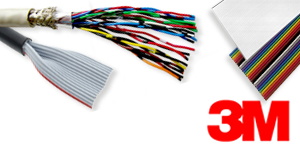 |
| Signal transmission via cables in electronic devices The electrical connections from one printed circuit board to another or from one assembly to the outside world are realized in most applications via cable sets in connection with input/output connectors. For these purposes, signal or control cables with cross-sections between 0.05mm² and 0.5mm² are usually used. Depending on the requirements, a choice can be made between flat cable or round cable. For electrical shielding, to protect the signals, cables with a protective shield made of foil and copper braiding can be used. A sheathing provides the mechanical protection of the cable.
Flat cables or ribbon cables - consist of parallel conductors and are used for signal transmission in electronic assemblies. A significant advantage of this cable version is the fast and easy processing with insulation displacement connectors, even or especially with high-pole cables. The colored marking of the edge conductor helps to position the cable in the connector. The use of individual cores as ground leads significantly reduces signal crosstalk. Round cable or flat round cables - these cables have been rolled up and provided with an outer sheath. Therefore they are also called flat round cables. The advantages of fast and easy processing with insulation displacement connectors and the reduced crosstalk between the signal conductors are retained. Optionally, the flat round cable is also available with a copper shield braid for protection against EMI. For greater flexibility, areas with spliced cores alternate with parallel areas. |



